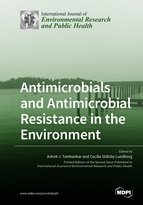Antimicrobials and Antimicrobial Resistance in the Environment
A special issue of International Journal of Environmental Research and Public Health (ISSN 1660-4601).
Deadline for manuscript submissions: closed (20 October 2018) | Viewed by 114255
Special Issue Editors
Interests: public health aspects of antibiotic residues; antibiotic resistant bacteria and antibiotic resistance genes in the environment especially water; interventions to mitigate spread in the environment of residues, bacteria and genes
Indian Initiative for Management of Antibiotic Resistance, Department of Environmental Medicine, R.D. Gardi Medical College, Agar Road, Ujjain, India
School of Biotechnology, KIIT university, Bhubaneswar, India
Interests: antimicrobial pollution of the environment; resistant microbes in the environment; remediation of antimicrobials, resistant microbes, and resistance genes from the environment
Special Issue Information
Dear Colleagues,
Antimicrobial resistance, especially antibiotic resistance, is considered one of the major challenges to global public health. A key driver for the development of antimicrobial/antibiotic resistance is exposure of microbes/bacteria to antimicrobials/antibiotics/metals. Very low levels of residue concentrations, that are often present in the environment, are sufficient to trigger resistance development. A One health perspective, i.e. seeing humans, animals and the environment as interconnected is essential for managing the antimicrobial/antibiotic resistance challenge. Involvement of antimicrobial/antibiotic residues/resistance in the environment should be a critical component of the One health approach. Antimicrobial spread in the environment results from the waste from the whole chain of events, from production to sales to utilization and excretion in metabolized or un-metabolized form after use. Much still needs to be known about the qualitative and quantitative spread of antimicrobial/antibiotic residues and resistance in the environment, the consequences of this spread, particularly the transfer of resistant bacteria and/or resistance genes from environmental microbes and commensals to pathogens infecting humans and/or animals. Even more important is to find implementable solutions to reduce the spread of antimicrobials/antibiotic residues and antimicrobial/antibiotic resistance and resistance markers in and from the environment.
This Special Issue seeks research papers on various aspects of antimicrobial/antibiotic residues, antibiotic resistant bacteria and antibiotic resistance genes in the environment and their remediation from the environment. Especially we encourage the submission of interdisciplinary work and multi-country collaborative research. We also encourage the submission of health systems and health policy-related manuscripts that focus on issues related to antimicrobial/antibiotic residues/resistance in the environment and the remediation aspect of it. We welcome original research papers using different study designs as well as systematic reviews and meta-analysis.
Prof. Cecilia StålsbyLundborg
Dr. Ashok J. Tamhankar
Guest Editors
Manuscript Submission Information
Manuscripts should be submitted online at www.mdpi.com by registering and logging in to this website. Once you are registered, click here to go to the submission form. Manuscripts can be submitted until the deadline. All submissions that pass pre-check are peer-reviewed. Accepted papers will be published continuously in the journal (as soon as accepted) and will be listed together on the special issue website. Research articles, review articles as well as short communications are invited. For planned papers, a title and short abstract (about 100 words) can be sent to the Editorial Office for announcement on this website.
Submitted manuscripts should not have been published previously, nor be under consideration for publication elsewhere (except conference proceedings papers). All manuscripts are thoroughly refereed through a single-blind peer-review process. A guide for authors and other relevant information for submission of manuscripts is available on the Instructions for Authors page. International Journal of Environmental Research and Public Health is an international peer-reviewed open access monthly journal published by MDPI.
Please visit the Instructions for Authors page before submitting a manuscript. The Article Processing Charge (APC) for publication in this open access journal is 2500 CHF (Swiss Francs). Submitted papers should be well formatted and use good English. Authors may use MDPI's English editing service prior to publication or during author revisions.
Keywords
Public health aspects of antimicrobial/antibiotic residues in the environment
Antimicrobial/antibiotic residues in the environment, antimicrobial/antibiotic/metal resistant microbes/bacteria in the environment, antimicrobial/antibiotic/metal resistance genes in the environment
Remediation of antimicrobials, resistance microbes and resistance genes from environmental, health systems and health policy focusing on issues related to antimicrobial/antibiotic residues/resistance in the environment and their remediation






